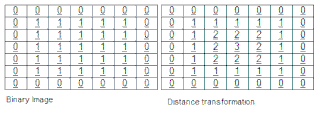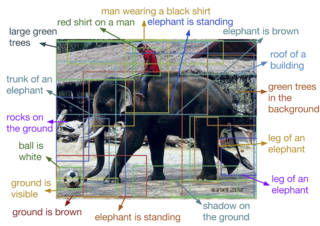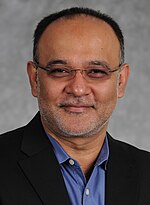The Association for Computing Machinery (ACM) is a US-based international learned society for computing. It was founded in 1947 and is the world's largest scientific and educational computing society. The ACM is a non-profit professional membership group, reporting nearly 110,000 student and professional members as of 2022. Its headquarters are in New York City.

A distance transform, also known as distance map or distance field, is a derived representation of a digital image. The choice of the term depends on the point of view on the object in question: whether the initial image is transformed into another representation, or it is simply endowed with an additional map or field.
General-purpose computing on graphics processing units is the use of a graphics processing unit (GPU), which typically handles computation only for computer graphics, to perform computation in applications traditionally handled by the central processing unit (CPU). The use of multiple video cards in one computer, or large numbers of graphics chips, further parallelizes the already parallel nature of graphics processing.

Gesture recognition is an area of research and development in computer science and language technology concerned with the recognition and interpretation of human gestures. A subdiscipline of computer vision, it employs mathematical algorithms to interpret gestures.

Automatic image annotation is the process by which a computer system automatically assigns metadata in the form of captioning or keywords to a digital image. This application of computer vision techniques is used in image retrieval systems to organize and locate images of interest from a database.
Ramesh Chandra Jain is a scientist and entrepreneur in the field of information and computer science. He is a Bren Professor in Information & Computer Sciences, Donald Bren School of Information and Computer Sciences, University of California, Irvine.

Takeo Kanade is a Japanese computer scientist and one of the world's foremost researchers in computer vision. He is U.A. and Helen Whitaker Professor at Carnegie Mellon School of Computer Science. He has approximately 300 peer-reviewed academic publications and holds around 20 patents.
Object recognition – technology in the field of computer vision for finding and identifying objects in an image or video sequence. Humans recognize a multitude of objects in images with little effort, despite the fact that the image of the objects may vary somewhat in different view points, in many different sizes and scales or even when they are translated or rotated. Objects can even be recognized when they are partially obstructed from view. This task is still a challenge for computer vision systems. Many approaches to the task have been implemented over multiple decades.
Activity recognition aims to recognize the actions and goals of one or more agents from a series of observations on the agents' actions and the environmental conditions. Since the 1980s, this research field has captured the attention of several computer science communities due to its strength in providing personalized support for many different applications and its connection to many different fields of study such as medicine, human-computer interaction, or sociology.
Informatics is the study of computational systems. According to the ACM Europe Council and Informatics Europe, informatics is synonymous with computer science and computing as a profession, in which the central notion is transformation of information. In some cases, the term "informatics" may also be used with different meanings, e.g. in the context of social computing, or in context of library science.
Computational journalism can be defined as the application of computation to the activities of journalism such as information gathering, organization, sensemaking, communication and dissemination of news information, while upholding values of journalism such as accuracy and verifiability. The field draws on technical aspects of computer science including artificial intelligence, content analysis, visualization, personalization and recommender systems as well as aspects of social computing and information science.
Multilinear principal component analysis (MPCA) is a multilinear extension of principal component analysis (PCA) that is used to analyze M-way arrays, also informally referred to as "data tensors". M-way arrays may be modeled by linear tensor models, such as CANDECOMP/Parafac, or by multilinear tensor models, such as multilinear principal component analysis (MPCA) or multilinear independent component analysis (MICA). The origin of MPCA can be traced back to the tensor rank decomposition introduced by Frank Lauren Hitchcock in 1927; to the Tucker decomposition; and to Peter Kroonenberg's "3-mode PCA" work. In 2000, De Lathauwer et al. restated Tucker and Kroonenberg's work in clear and concise numerical computational terms in their SIAM paper entitled "Multilinear Singular Value Decomposition", (HOSVD) and in their paper "On the Best Rank-1 and Rank-(R1, R2, ..., RN ) Approximation of Higher-order Tensors".
Nicolai Petkov is computer scientist and professor emeritus of Intelligent Systems and Computer Science at the University of Groningen, known for his contributions in the fields of brain-inspired computing, pattern recognition, machine learning, and parallel computing.

Hanspeter Pfister is a Swiss computer scientist. He is the An Wang Professor of Computer Science at the Harvard John A. Paulson School of Engineering and Applied Sciences and an affiliate faculty member of the Center for Brain Science at Harvard University. His research in visual computing lies at the intersection of scientific visualization, information visualization, computer graphics, and computer vision and spans a wide range of topics, including biomedical image analysis and visualization, image and video analysis, and visual analytics in data science.

Gregory D. Hager is the Mandell Bellmore Professor of Computer Science and founding director of the Johns Hopkins Malone Center for Engineering in Healthcare at Johns Hopkins University.
Jiebo Luo is a Chinese-American computer scientist, the Albert Arendt Hopeman Professor of Engineering and professor of computer science at the University of Rochester. He is interested in artificial intelligence, data science and computer vision.
Wolfgang Heidrich is a German-Canadian computer scientist and Professor at the King Abdullah University of Science and Technology (KAUST), for which he served as the director of Visual Computing Center from 2014 to 2021. He was previously a professor at the University of British Columbia (UBC), where he was a Dolby Research Chair (2008-2013). His research has combined methods from computer graphics, optics, machine vision, imaging, inverse methods, and perception to develop new Computational Imaging and Display technologies. His more recent interest focuses on hardware-software co-design of the next generation of imaging systems, with applications such as high dynamic range (HDR) imaging, compact computational cameras, hyper-spectral cameras, wavefront sensors, to name just a few.






